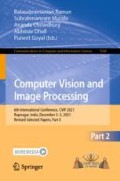Abstract
COVID-19 disease discovered from the novel corona virus can spread through close contact with a COVID-19 infected person. One of the measures advised to contain the spread of the virus is to maintain social distancing by minimizing contact between potentially infected individuals and healthy individuals or between population groups with high rates of transmission and population groups with no or low-levels of transmission. Motivated by this practice, we propose a deep learning framework for social distance detection and monitoring using surveillance video that can aid in reducing the impact of COVID-19 pandemic. This work utilizes YOLO, Detectron2 and DETR pre-trained models for detecting humans in a video frame to obtain bounding boxes and their coordinates. Bottom-centre points of the boxes were determined and were then transformed to top-down view for accurate measurement of distances between the detected humans. Based on the depth of each bottom-centre point estimated using monodepth2, dynamic distance between pairs of bounding boxes and corresponding distance threshold (safe distance) to prevent violation of social distancing norm were computed. Bounding boxes which violate the distance threshold were categorized as unsafe. All the experiments were conducted on publicly available Oxford Town Center, PETS2009 and VIRAT dataset. Results showed that Detectron2 with top-down view transformation and distance thresholding using pixel depth estimation outperformed other state-of-the-art models. The major contribution of this work is the estimation and integration of variable depth information in obtaining the distance threshold for evaluating social distances between humans in videos.
Access this chapter
Tax calculation will be finalised at checkout
Purchases are for personal use only
References
Afiq, A., Norliza, Z., Mohd, F.: Person detection for social distancing and safety violation alert based on segmented ROI. In: 2020 10th IEEE International Conference on Control System, Computing and Engineering (ICCSCE), pp. 113–118 (2020). https://doi.org/10.1109/ICCSCE50387.2020.9204934
Imran, A., Misbah, A., Joel, R., Gwanggil, J., Sadia, D.: A deep learning-based social distance monitoring framework for COVID-19. Sustain. Cities Soc. 65, 102571 (2021). ISSN 2210-6707
Yew, C., Mohd, Z., Salman, Y., Sumayyah, D.: Social distancing detection with deep learning model. In: 2020 8th International Conference on Information Technology and Multimedia (ICIMU), pp. 334–338 (2020). https://doi.org/10.1109/ICIMU49871.2020.9243478
Narinder, P., Sanjay, S., Sonali, A.: Monitoring COVID-19 social distancing with person detection and tracking via fine-tuned YOLOv3 and deep sort techniques (2020). http://arxiv.org/abs/2005.01385
Mohammad, S., Shamim, H., Mohammed, A.: Towards the sustainable development of smart cities through mass video surveillance: A response to the COVID-19 pandemic. Sustain. Cities Soc. 64, 102582 (2021). ISSN 2210-6707
Lin-Bo, K., In-Sung, K., Kyeong-yuk, M., Jun, W., Jongwha, C.: Low-cost implementation of bird’s-eye view system for camera-on-vehicle. In: ICCE 2010 - 2010 Digest of Technical Papers International Conference on Consumer Electronics, pp 311–312 (2010). https://doi.org/10.1109/ICCE.2010.5418845
Joseph, R., Ali, F.: Yolov3: An incremental improvement. arXiv preprint arXiv:1804.02767 (2018)
Alexey, B., Chein-Yao, W., Hong-Yang, L.: Yolov4: Optimal speed and accuracy of object detection, arXiv preprint arXiv:2004.10934 (2020)
Glen, J., Alex S., Jirka, B., Ayush, C., Liu, C., Abhiram, V., Jan, H., Laurentiu, D., Yonghye, K.: Ultralytics/yolov5(v5.0), https://doi.org/10.5281/zenodo.4679653Detectron2 (2021). Accessed 16 Oct 2020
https://github.com/facebookresearch/detectron2/blob/master/MODELZOO.md. Accessed 16 Oct 2020
Nicolas, C., Fransisco, M., Gabriel, S., Nicolas, U., Alexander, K., Sergey, Z.: End-to-End Object Detection with Transformers (2020)
Clement, G., Oisin, A., Micheal, F., Gabriel, B.: Digging into self-supervised monocular depth estimation. arXiv preprint arXiv:1806.01260 (2018)
Yolo_Label (2020). https://github.com/developer0hye/Yolo_Label. Accessed 16 Oct 2020
Oxford Town Centre video data: http://www.robots.ox.ac.uk/ActiveVision/Research/Projects/2009bbenfold_headpose/project.html. Accessed 16 Oct 2020
PETS2009 dataset: http://www.cvg.reading.ac.uk/PETS2009/a.html. Accessed 17 Oct 2020
VIRAT Video Dataset: https://viratdata.org/. Accessed 18 Oct 2020
Acknowledgements
We are grateful to the International Institute of Information Technology Bangalore (IIITB), India for the infrastructure support. We are thankful to Infosys Foundation for the financial assistance and project grant through the Infosys Foundation Career Development Chair Professor.
Author information
Authors and Affiliations
Corresponding author
Editor information
Editors and Affiliations
Rights and permissions
Copyright information
© 2022 The Author(s), under exclusive license to Springer Nature Switzerland AG
About this paper
Cite this paper
Nair, P., Kumar, U., Nandan, S. (2022). COVID-19 Social Distance Surveillance Using Deep Learning. In: Raman, B., Murala, S., Chowdhury, A., Dhall, A., Goyal, P. (eds) Computer Vision and Image Processing. CVIP 2021. Communications in Computer and Information Science, vol 1568. Springer, Cham. https://doi.org/10.1007/978-3-031-11349-9_25
Download citation
DOI: https://doi.org/10.1007/978-3-031-11349-9_25
Published:
Publisher Name: Springer, Cham
Print ISBN: 978-3-031-11348-2
Online ISBN: 978-3-031-11349-9
eBook Packages: Computer ScienceComputer Science (R0)

